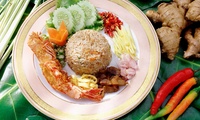GROUPON GUIDE TO CHICAGO
Kare-Kare: The Tastiest Filipino Dish You've Never Ordered
Apr 30, 2018
Deals in chicago

$30 or $60 Towards Food and Drinks or Pad Thai or Red Snapper for Two
4825 North Western Avenue, Chicago • 7.0 mi
Sale Ends 12/19
3 bought
Madame Puffs and Thai Bistro

Indulge in a 7-Course Peking Duck Feast for Two at Lao Sze Chuan
520 Michigan Avenue, Chicago • 0.8 mi
Sale Ends 12/19
Lao Sze Chuan

Trending
Taste authentic Japanese cuisine with $25 or $50 options
2255 West North Avenue, Chicago • 3.7 mi
Sale Ends 12/19
Izakaya Shinya

Single Diner Special, Dinner for Two, Family & Group Feast, and More
2002 South Wentworth Avenue, Chicago • 1.8 mi
Sale Ends 12/19
Noodleverse 面八方

Trending
Up to 46% Off on Japanese Cuisine at Runa Izakaya
7138 183rd Street, Tinley Park • 23.8 mi
Sale Ends 12/19
Runa Izakaya
Deals in chicago Other Deals in chicago

Enjoy Sushi and Thai Flavors for Two or More People
2187 North Clybourn Avenue, Chicago • 3.5 mi
Sale Ends 12/19
Rock Wrap & Roll

Indulge in a 7-Course Peking Duck Feast for Two at Lao Sze Chuan
520 Michigan Avenue, Chicago • 0.8 mi
Sale Ends 12/19
Lao Sze Chuan

$30 or $60 Towards Food and Drinks or Pad Thai or Red Snapper for Two
4825 North Western Avenue, Chicago • 7.0 mi
Sale Ends 12/19
3 bought
Madame Puffs and Thai Bistro


